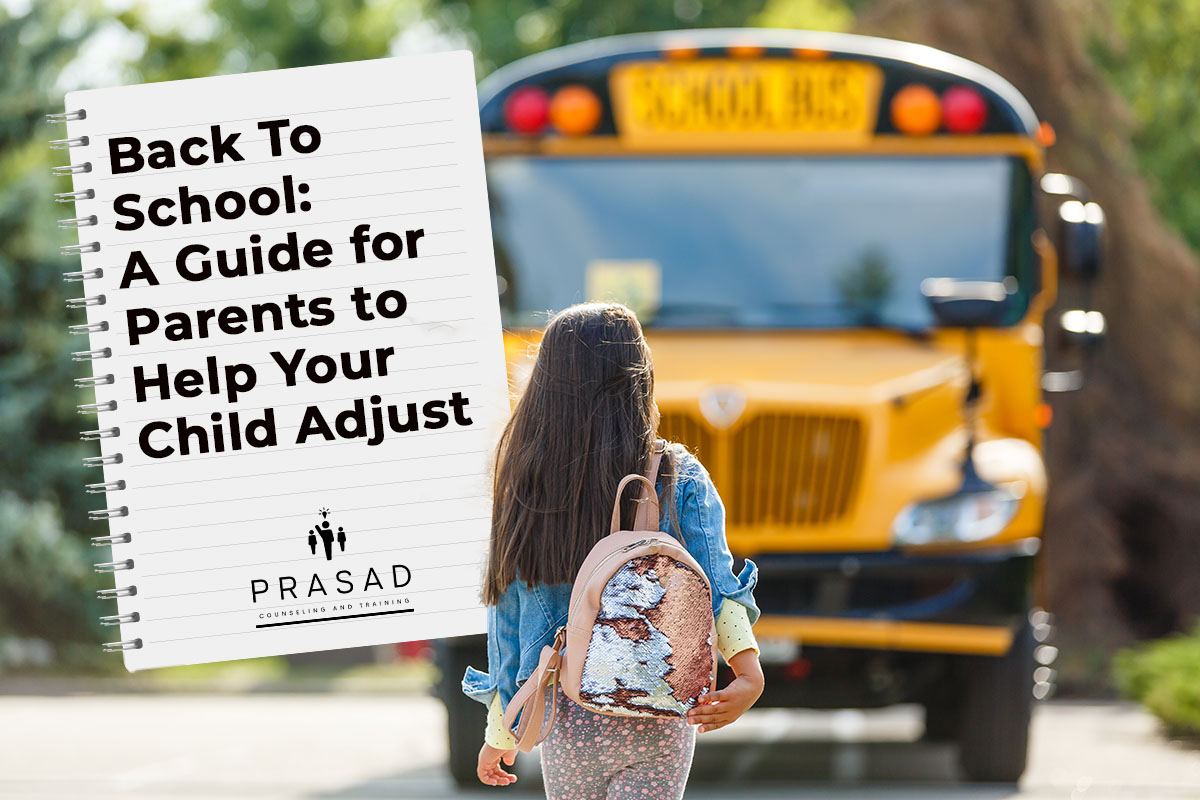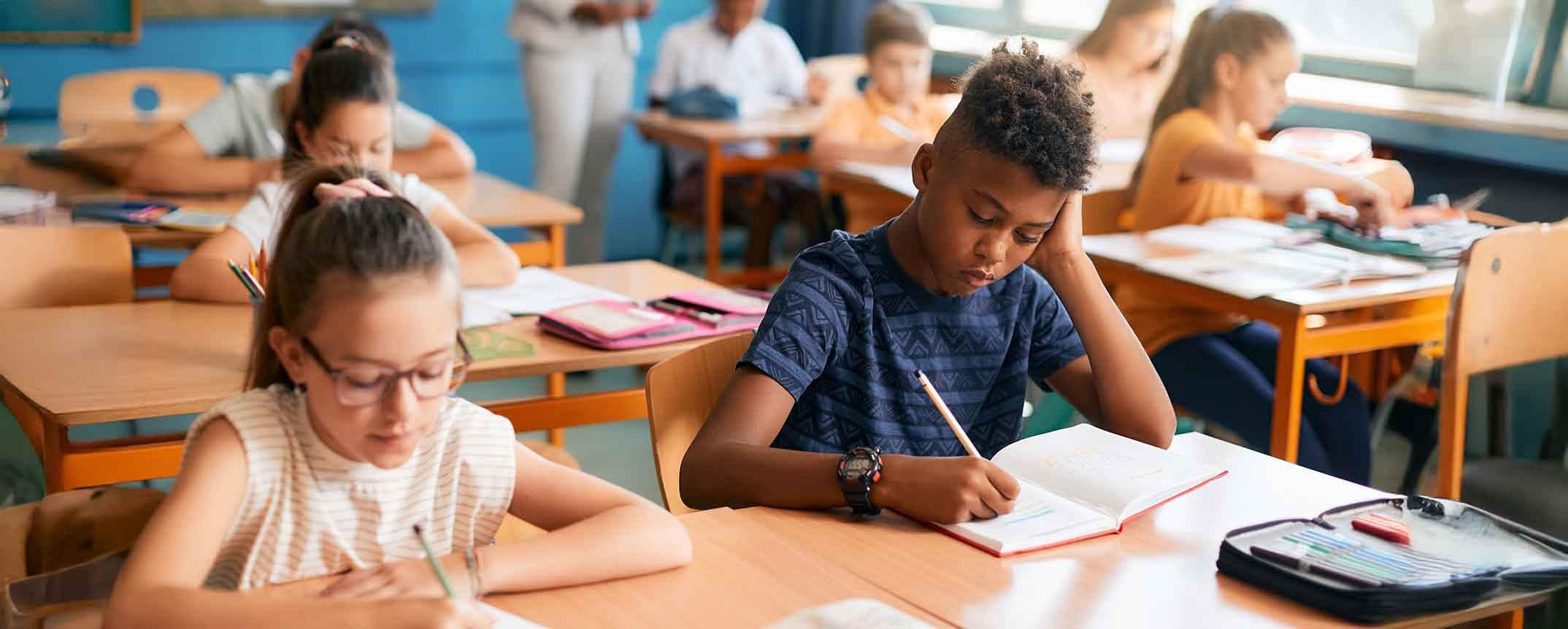How to Help Your Kid Get Back into the Groove of School
How can you help your child or teen transition back to school with less stress and more support?
Back-to-school transitions present several key challenges for children and teenagers across different developmental stages. While the areas impacted are often similar—academically, socially, and routinely—the way these challenges manifest can differ by age.
This guide was developed with support from LPC-Associate Katelyn Klein, who crafted the “How to help” strategies throughout the piece.
Academic Pressures and Expectations:
Students of all age groups often face increased academic demands, new subjects, and higher performance expectations.
- Children: Starting a new grade level brings concerns about keeping up with schoolwork, meeting teacher expectations, and performing well on tests. Some children worry about being “smart enough” or comparing themselves to peers.
- Teens: The shift from summer’s relaxed pace to structured learning can create stress, especially when dealing with more challenging coursework or standardized testing pressures.
How to help
Teach your children about effective studying skills, such as implementing 15-minute breaks for every hour of studying and finding what study strategies work best for them. Also, encourage a healthy academic and life balance, maintain open communication regarding academic stress, and involve teachers or tutors to support the child if they need extra support.
Social Dynamics and Peer Relationships:
Navigating friendships, peer pressure, and social hierarchies become particularly intense during school transitions.
- Children: They often worry about fitting in, maintaining existing friendships, or dealing with bullying. They may feel anxious about being accepted or fear of being left out of social groups.
- Teenagers: It is common for teens to feel additional complexities around identity formation and romantic relationships.
How to help
Regarding your child’s social relationships, maintain an open line of communication so they feel comfortable enough to talk about peer pressures and bullying. Another important strategy parents can use is modeling good behaviors and healthy communication skills with family and friends. Also, parents can teach their children about effective conflict resolution skills and foster empathy to effectively teach their children how to work with difficult peers.
Routine and Schedule Adjustments:

Adapting to sleep schedules, mealtimes, and daily routines after months of summer flexibility can be physically and emotionally taxing.
- Children: Learning with new teachers and in new classrooms, school buildings, or even entirely new schools can feel intimidating, especially for shy children or those who had difficult experiences with previous teachers. Children may resist the return to homework, bedtimes, and less free play time. They need time to learn new routines, rules, and expectations.
- Teenagers: Often shifting to late-night habits over the summer, making the switch to early school mornings can be difficult, leading to irritability, low energy, and poor focus.
How to help
One helpful strategy is to establish a routine and ease the children into it towards the end of their summer break. For example, try establishing the new wake and sleep time changes before school starts to make their transition easier. Workbooks can also help a child ease back into a homework routine and encourage academic readiness before the school year begins. Make sure to allow time for children and teenagers to adjust to the new schedule and practice patience.
![]() Learn More: a good night sleep is vital, but for teenager’s, it may seem like a battle. Read our helpful guide on the importance of sleep for teens’ abilities and mental health and how to help ensure they get a full night’s sleep. Read more in our blog “Sleep and Teens: Why it Matters”
Learn More: a good night sleep is vital, but for teenager’s, it may seem like a battle. Read our helpful guide on the importance of sleep for teens’ abilities and mental health and how to help ensure they get a full night’s sleep. Read more in our blog “Sleep and Teens: Why it Matters”
Separation Anxiety and Independence:
After many months at home, attachment and independence issues often come to the surface.
- Children: Many younger children struggle with leaving parents or caregivers, especially after spending more time together during summer break. This can manifest as crying, clinging, or physical complaints like stomachaches.
- Teenagers: Older students might feel overwhelmed by increased independence and responsibility for their academic success.
How to help
Regarding separation anxiety with children, it’s important for parents to stick to the routine, maintain a positive attitude towards school and teachers, and consider using a comfort item such as a toy that the child can take to school until their anxiety lessens. With teenagers, parents should provide more decision-making opportunities and establish age-appropriate responsibilities such as chores. Overall, listening to your children’s concerns and helping them maintain a positive outlook is important for children of any age.
Technology and Digital Challenges:
Nowadays, back-to-school doesn’t just mean new pencils and notebooks but also navigating the digital aspects of the classroom.
- Children: The transition from unstructured summer days to screen time boundaries and adapting to digital tools used for learning can feel confusing.
- Teenagers: Oftentimes, teens may feel pressures around social media, cyberbullying, and balancing screen time with academic responsibilities. The digital learning tools introduced during recent years have also created new adjustment challenges.
How to help
With children, it’s important to limit screen time even during the summer breaks. Setting clear boundaries and maintaining them with any electronics is important regarding children’s responsibility with technology. Parents should also be wary of the dangers of the internet and social media for both children and teenagers. Monitoring your child’s social media and teaching them internet safety is paramount when raising children and teens in a technology-based world.
Financial and Resource Stress:
School-related costs can add stress for children and teens alike.
Children and teenagers: Even young children can feel self-conscious about their clothes, school supplies, or appearance compared to their classmates. These concerns can create anxiety for both students and families, particularly affecting students from lower-income households.
How to help
With both children and teens, parents must model solution- and positive-focused behaviors. For example, teaching your child the value of a dollar and financial responsibility from an early age will help them feel less financial stress in the future. Parents must be open and honest with children regarding their financial standing and reassure them that their needs will be met. If your children face peer pressure or bullying due to financial differences, involve the teacher and remind your child that there is more to life than having the newest trends.
Physical & Mental Health Considerations:
The physical and emotional toll of returning to school is often underestimated.
- Children: Sitting for longer periods, carrying heavy backpacks, and adjusting to school lunch schedules can cause physical discomfort. Some children also experience stress-related symptoms like headaches or upset stomachs.
- Teenagers: The combination of these stressors can trigger or worsen anxiety, depression, and other mental health challenges, with teenagers being particularly vulnerable during this transitional period.
How to help
Having children in a sports-related activity can improve both physical and mental health. Exercise that the child finds enjoyable can help reduce stress, anxiety, and improve physical health. In addition, it’s important for children and teens to attend yearly physicals. As guardians, make sure to listen to your children if they express physical discomfort.
Final Thoughts:
These challenges vary significantly based on age, previous experiences, family support, and individual personality traits, but recognizing them helps parents, educators, and students prepare more effectively for successful transitions.

Don’t panic! They typically ease as children and teenagers settle into their new routines, usually within the first few weeks of school. Patience, preparation, and open communication help students navigate this transition more successfully.
The advice provided in this helpful guide was crafted by LPC Katelyn Klein, one of the many licensed clinicians at Prasad Counseling and Training. Katelyn is our expert when working with children as young as 12 years old and teenagers. She has a strong understanding of individual and group psychotherapy and substance abuse, having worked as a counselor in family therapy and eating disorder settings. Contact our office to learn more about her services and the other types of group and individual therapy options available to you.





